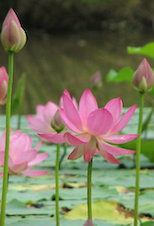Jodo Wasan 28
Sakyamuni Buddha states
That even with his unhindered eloquence,
The adornments of the land of happiness cannot
be fully expounded;
So take refuge in Amida, the inexpressible Buddha.
The Supremely Difficult Thing
Shinran Shonin calls to us to take refuge in the ineffable Buddha, Amida - whose land is beyond description. In matters relating to dharma, a point is always reached beyond which words cannot take us.
Indeed, a short time after his enlightenment, Shakyamuni decided that it was not really worth the effort of trying to teach dharma because it was not only too profound for most people to understand but also too difficult to teach.
The dharma to which I have awakened is truly difficult to awaken to. It is quiescent and unexcelled and difficult to attain through ordinary reason. Deep and profound, only the wise man is able to know and attain it. How can the peoples of this world who are addicted to the pleasures of desire know such truths ... 1
The gods, alarmed at the news that Shakyamuni was thinking in that way appointed Brahma to visit Shakyamuni and try to persuade him to change his mind. Moved by compassion for suffering beings, Shakyamuni saw their diversity and that some would be accessible to his teachings.

Again the spiritual capacities of a diversity of people were clearly reflected in the World Honoured Ones eyes. Much like a lake filled with lotuses. In that lake there are lotuses that are blue, yellow, red and white in colour. Some lotuses sprout in the water and never break the surface of the water. Some lotuses sprout in the water, grow in the water and remain on the surface of the water, rise above the water and yet, they are never touched by the water. Then the World Honoured One answered Brahma with a verse:
Oh Brahma, perceiving the futility of it all, I refrained from expounding the teaching to the people. However, those who have ears to hear shall hear and attain faith heart. I shall open the doors of immortality.2
'The dharma to which I have awakened is ... quiescent and unexcelled and difficult to attain through ordinary reason.' Shakyamuni's lament is a recurring feature of the entire process of transmitting dharma from person to person and generation to generation. It is even so in the Pure Land tradition. Down through the ages the original lament at the end of the Larger Sutra is re-affirmed over and over again by Pure Land teachers, including Shinran.
It is difficult to meet and difficult to hear the teaching of the Buddhas. It is difficult to hear the excellent teachings of the bodhisattvas - the paramitas. It is also difficult to meet a true teacher, hear the teaching, and put it into practice.3
Shakyamuni was often reduced to silence, sometimes because he did not think topics were relevant - for example, how the world was created or the 'range of karma'. At other times, when something was too profound and ineffable. This is certainly the case when it comes to the Pure Land. It too is described as being filled with different coloured lotuses, reflecting the same diversity which was described by Shakyamuni as he pondered the question of propagating the dharma just a few weeks after his enlightenment. The adornments of the Pure Land testify to its perfection as the realm of the eternal dharma, as transcending anything we can know. Even the most awe-inspiring eloquence could not convey its full reality.
Although from Nagarjuna's time the Pure Land way has been described as 'the easy path' it has never really been so. Certainly it is easy to be born in the Pure Land and that is not where the difficulty lies. It is not even the scepticism and derision that often greets followers of the Pure Land way. The difficulty lies in the concept of 'practice' in the Pure Land tradition. People are used to the idea of practice as a set of precepts, or tasks, which when carried out, bring about certain results.
There are no such blue prints in the Pure Land tradition for which the only tangible thing is the Name (myogo) - Namo Amida Butsu. Furthermore, the Name is the vehicle by which we hear dharma and awaken to Amida Buddha's shinjin - the cause of ultimate liberation. Having awakened to shinjin the Name continues to live but with a new significance: as the expression of shinjin, and as the mark of gratitude.
It is extremely rare for this to be immediately obvious to followers of Buddha Dharma. Hence the difficulty. Yet if the difficulty can be surmounted, often through perseverance, the reward is inexpressible and the way of nembutsu-shinjin - that is, Jodo Shinshu - is clearly seen as true, remarkable and unsurpassed.
In order to 'hear' the Name, we need to listen (chomon) carefully, and with dedication: through reading, and attending dharma talks; thinking about life as we actually experience it, rather than some kind of idealissed image of the way things are supposed to be.
Without doubt, Shinran provided a most skillful vehicle for hearing the Name in these three volumes of verses.
1: Vinaya Pitaka: Maha Vagga.
2: Vinaya Pitaka: Maha Vagga.
3: The Three Pure Land Sutras, Vol II, THe Sutra of the Buddha of Immeasurable Life [TPLS II], Shin Buddhism Translation Series, 2009 p. 102.